his solution by an actual cut, and then brought me written out the process of reasoning whereby he had solved the problem.
The process of reasoning in question, or any process of reasoning by which the problem could be solved in advance of actually cutting the strip, is in part a genuine instance of deductive reasoning. Just because of the intimate mingling of empirical data and of exactly definable relationships, the case in question forms an admirable instance of the study of the genuine psychology of the deductive process; but I confess that no psychologist would make much of the study who was not fairly well acquainted with deductive processes of a certain complexity,—processes which in their more exact forms you will find anywhere in pure mathematics, where a symbolic language with an exact definition is used, as the only means of presenting data to the imagination.
Let me mention another instance of a deductive process of some complexity, but of great ingenuity and of interesting psychological relationships. We know that about 500 b. c. a member of the Pythagorean school discovered that granting the ordinary principles of metrical geometry as they were then and ever since have been used, the diagonal of a square could not be commensurate with the side of the square. The strictly deductive portion of this proof can be with fair ease distinguished from that portion of the proof in question which is indeed empirical and not deductive. That figures resembling squares exist is a matter of experience. That if you make a square exactly enough and large enough, and measure carefully enough you will discover that by no rule you seem to be certain of stating the ratio of diagonal to side exactly in terms of whole numbers: this again is so far empirical. And the ordinary so-called axioms of metrical geometry, considered as principles about the constitution of the physical world, are of course generalizations from physical experience. On the other hand, the purely mathematical portion of geometry, that is, the purely deductive portion, consists in the discovery, not that the geometrical axioms are self-evident or otherwise certain, and not that the physical world has any properties whatever, but that certain assumed geometrical principles which can be stated wholly in symbols, actually imply certain geometrical conclusions. Now the early Greek geometer who discovered that the diagonal and the side of the square are from the point of view of geometrical theory incommensurable, was no doubt guided by the empirical difficulty of discovering any rule whereby a common measure for the diagonal and the side could be stated. Furthermore, he was not clear in his own mind as to the precise distinction between the deductive and the inductive part of his geometrical science. But he was possessed of the power to draw an exact deductive conclusion. And what lie found out was that if certain principles of measurement and certain purely mathematical properties of whole numbers be admitted, the diagonal and
